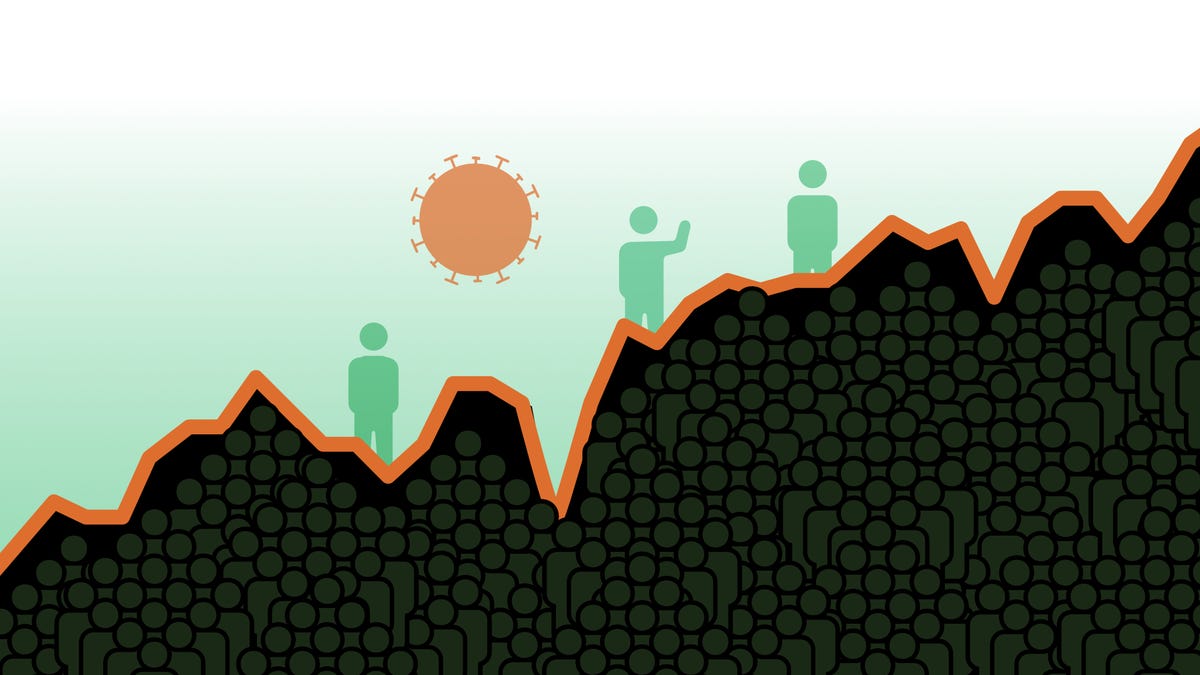LATEST FINANCIAL NEWS
In the year of COVID-19, who has really benefited from the stock market boom?
What is an IPO? Here’s what you need to know before you start investingThe stock market saw a record number of IPOs last year. And 2021 is looking just as strong. Here’s what needs to happen for a company to go public.Just the FAQs, USA TODAYIf you want to know what a K-shaped recovery feels like for working Americans, start with Page Benjamin.As an unemployed single mother of two young children, Paige Benjamin has no emergency savings to fall back on and can’t fathom starting to invest at this stage of her life.“I’m just trying to survive,” she says.Benjamin, 34, who lives in Breaux Bridge, Louisiana, is an Army veteran and worked as a full-time associate at Walmart last year, making $11.50 an hour. Her hours were reduced once the pandemic hit. Then in the fall, she was forced to leave work and file for unemployment because she couldn’t afford child care when her kids were doing remote learning. Money has been tight and she’s struggled to pay bills. Her internet has been cut off multiple times this year, a big issue for virtual schooling. Now she’s worried that her electricity could get shut off at a moment’s notice. “Investing seems so far gone from what I can actually do,” says Benjamin, who is Black. “It’s been so hard to get help for the people who really need it. You can’t build wealth.”But you wouldn’t get a sense of these struggles by looking at today’s stock market.Paige Benjamin, an unemployed Army veteran who lives in Breaux Bridge, Louisiana, with her two children.Paige BenjaminWho loses and who wins: These cities could become the biggest winners and losers as more Americans shift to remote work’I’m literally breaking inside’: As COVID-19 leaves millions jobless and struggling, the mental health toll risesMajor stocks indexes are hitting record highs after the worst global pandemic in a century hit last spring, taking more than 500,000 lives and battering the U.S. economy.Despite historic job losses since then, the S&P 500, the benchmark used to track most mutual funds, has surged more than 75% as trillions of dollars in stimulus from the Federal Reserve and Congress propped up an economy gripped by recession and industries like tech soared as more people shopped, socialized and worked online.While some Americans have seen their stock holdings balloon in value, not everyone has been able to take advantage of the market rebound to build wealth during the market’s recovery.Deep financial scars have been inflicted by the pandemic, with low-income households, minorities and women, in particular, suffering stinging job losses, which have only widened the divide between the haves and have-nots. Even if everything had been fine, so many people don’t earn enough extra income to put money into stocks. But for those who had managed to create some retirement savings, the pandemic of the past year has forced them to yank money from those nest eggs.“Who benefits when stocks are at records? The very top,” says Yosef Bonaparte, an economics professor at the University of Colorado Denver. “We’ve never seen one event like the pandemic increase inequality so much in a year,” he adds, stressing that the wealth inequalities emerging during the pandemic have eclipsed those that existed during the Great Recession. Although job growth is expected to build in the coming months thanks to vaccinations and another round of stimulus, economists say that it may take several years for the labor market to heal. So far, the economy has recouped 12.7 million of the 22.2 million jobs lost in the pandemic recession.“There was a lot of pain for poor households who withdrew from their retirement after losing their job,” Bonaparte says. “Some sold their pensions and got penalized, but then the market recovered and they missed out.”Wealth disparities were widening even before the pandemic. But over the past year, experts say nearly half of Americans likely missed out on the stock market gains. About 53% of U.S. households held stocks in 2019, according to the Federal Reserve’s Survey of Consumer Finances, a snapshot of U.S. household financial health that is updated every three years. The figure includes indirect ownership through retirement accounts, such as 401(k) plans.That means 47% of U.S. families own no stock. But among those who do, the gaps in ownership are striking. The top 1% of Americans by wealth account for $21 trillion of household stock ownership, or 53%, according to Goldman Sachs. By contrast, the bottom 90% of households own $5 trillion of stocks, or 13%, while the bottom half holds just 1% of the stock market, a share that has remained little changed for more than three decades. The stock market’s rebound over the past year has likely had little effect on building wealth for millions of American households, according to Heidi Shierholz, an economist at the Economic Policy Institute, a left-learning think tank.That’s because when the market is booming, the majority of the gains go to the wealthiest households, she says. “For the vast majority of people, fluctuations in the stock market have very little effect on their wealth,” says Shierholz. “Most people don’t have sizable, if any, amount of money in the stock market, even including stocks held indirectly through retirement accounts.”Another issue is that the people with the least wealth have endured the most job losses in the pandemic, Shierholz says. The lowest-paid quarter of workers lost 8 million jobs in 2020 while the highest-paid quarter of workers gained 1 million jobs, according to Shierholz.“It’s always the case that low and middle-income workers get hit harder by recessions, but I’ve never seen something this stark,” Shierholz says. “It really compounds the suffering because it’s the people who don’t have savings or wealthier families to fall back on in hard times,” she adds.Investing in stocks can be risky, but it’s a valuable way to build wealth over time. Stock market booms benefit those who hold the most shares. So the more stocks an investor holds, the greater their overall gains are through their ability to buy even more shares where they can receive or reinvest dividends.One of the most common ways that Americans own stock is through retirement savings vehicles like company-sponsored 401(k) plans or Individual Retirement Accounts. The average retirement balance had grown just 2% to $65,000 from 2016 to 2019, according to the Survey of Consumer Finances. Around three in four families own $40,000 or less in stocks.Even for families with access to an employer-sponsored retirement plan, not all of them participate.In fact, more working-age families have the option to put money into retirement plans than actually do, and participation varies by race.Overall, about 60% of white families participate in a retirement plan, compared with 44% of Black families and 34% of Hispanic families, according to the Fed. And of families with access to plans, about 90% of white families participate, compared with about 80% of Black families and about 75% of Hispanic families.A variety of factors influence how much people participate, including whether a family has sufficient income to save, the types of funds offered by employer-sponsored plans, whether participation is by default or voluntary and how much financial literacy a household has, experts say. About 57% of U.S. households show signs they lack basic investing knowledge, according to Bonaparte. These signs include people pulling money out of the market on momentary fears, not buying and holding stock long term in order to make gains, or failing to participate in the stock market at all. And that makes it even harder for working people to build up savings using the stock market, however limited their access is compared with the wealthier households.”By not participating … you’re taking a risk with your retirement,” says Bonaparte, who added that an investor’s money can grow substantially over time using the power of compound interest. “We need to have financial literacy classes in more schools.”Christina Collucci, 50, counts herself lucky that her husband is a firefighter who remains employed with a pension. She was laid off last spring from her freelance gig at an online apparel company.Even though she already had a traditional IRA, the pandemic inspired her to take control of their finances as she and her husband neared retirement. After reading a handful of investing books, she put money she’d saved from their stimulus checks in a Roth IRA, which she maxed out for both 2020 and 2021. Now she’s kicking herself for not learning more about investing sooner.“There are a lot of adults my age who didn’t learn any of these things growing up,” says Collucci, who lives in Pompton Plains, New Jersey. “I don’t want my daughters to be in the same place as me at 50 years old,” she continues, adding, “We’re in a good place, but we could have been in such a better one through basic financial knowledge.”Others, however, think the issue is beyond financial literacy.For someone who averages $40,000 in income a year, it would be nearly impossible for them to put enough in a 401(k) to secure their retirement, even with compound interest, says William Spriggs, a professor of economics at Howard University and chief economist to the AFL-CIO. One issue is that median household incomes haven’t budged in 20 years, he adds. “You can’t save your way to being wealthy,” says Spriggs. “So many people make so little money. Poor people are getting poorer in the pandemic.”William Spriggs, professor of economics at Howard University and chief economist to the AFL-CIO.If you’re a low-wage worker, you don’t have the wherewithal to risk anything.“Would I tell a minimum wage worker to get in on the GameStop frenzy? I don’t know if I would do that because they only have a small amount of money. Do you in essence gamble?” Spriggs says. “It’s not a financial literacy thing. If you’re a low-wage worker, you don’t have the wherewithal to risk anything.”Wealth accumulation has been difficult for minorities in particular. The typical white family has eight times the wealth of Black families, and five times the wealth of the Hispanic families, according to the Fed.Millions of Americans used to rely on private corporate pensions for their golden years. But the number of corporate pension plans with 100 or more members has dropped from almost 26,000 in 1983 to about 8,400 in 2016, according to the AARP, citing data from the U.S. Department of Labor. Society needs to reform Social Security to shore up Americans’ finances, according to Spriggs, because the current system isn’t set up to allow most people to comfortably invest on their own in stocks.Wealth disparities among racial groups in America are caused by multiple factors, including a long legacy of intense discrimination that has led to differences in education and income, according to Allison Schrager, a senior fellow at the Manhattan Institute, an economic think tank.For instance, about 60% of white households own stock, compared with just 33% of Black households, Schrager said. “Stock ownership has risen sharply since the 1980s, mainly through retirement accounts, but you need to have access to one,” says Schrager. “Minorities tend to work in lower-paid jobs without benefits.”Access to the stock market is a key issue. “Expanding access to retirement accounts for more Americans is a good start to fixing this,” Schrager says. “A government program could be used to make it cheaper and easier for smaller employers to offer retirement accounts.”Black Americans are much less likely to own high-return assets than white households, including homes, stocks and their own businesses, experts say. Single Black women, for instance, are six times less likely to own stocks than single men and nearly 50% less likely to own a home, according to Goldman Sachs.While Black Americans aren’t benefiting from stock market growth at the same rate as white Americans at similar income levels, there are signs of growing engagement in the stock market by younger African Americans, according to the recent Ariel-Schwab Black Investor Survey.About 55% of Black Americans and 71% of white Americans report stock market investments. But three times as many Black investors as white investors (15% vs. 5%) reported investing for the first time in 2020.The survey wasn’t clear why, though Carrie Schwab-Pomerantz, president of Charles Schwab Foundation, has a few theories. The stock market boom has drawn a lot of attention to investing recently and access to trading is now easier than it was in recent decades because of online brokerages like Robinhood, she says.Still, there was a troubling sign: COVID-19 affected Black Americans retirement savings in more negative ways than their white counterparts. Roughly 12% of Blacks borrowed from their workplace retirement plans, compared with 5% of whites.“Black Americans were more likely to be in jobs that were affected by the pandemic,” says Schwab-Pomerantz. “Because they have lower pay, they have less money to ultimately draw on. So it’s not surprising that they had to borrow from their 401(k)s or family.”“Many Black and Hispanic workers aren’t thinking about investing in the stock market,” says Kristen Broady, a fellow in economics studies at the Brookings Institution and policy director of the think tank’s Hamilton Project. “They’re thinking about how to pay their bills.”GRAPHICS George Petras/USA TODAY
Source link









